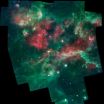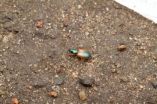(Press-News.org) The stars we see today weren't always as serene as they appear, floating alone in the dark of night. Most stars, likely including our sun, grew up in cosmic turmoil — as illustrated in a new image from NASA's Spitzer Space Telescope.
The image shows one of the most active and turbulent regions of star birth in our galaxy, a region called Cygnus X. The choppy cloud of gas and dust lies 4,500 light-years away in the constellation Cygnus the Swan. Cygnus X was named by radio astronomers, since it is one of the brightest radio regions in the Milky Way. (It should not be confused with the black hole Cygnus X-1.)
Cygnus X, which spans an area of the sky larger than 100 full moons, is home to thousands of massive stars, and many more stars around the size of our sun or smaller. Spitzer has captured an infrared view of the entire region, which is bubbling with star formation.
"Spitzer captured the range of activities happening in this violent cloud of stellar birth," said Joe Hora of the Harvard-Smithsonian Center for Astrophysics, who is the principal investigator of the research. "We see bubbles carved out from massive stars, pillars of new stars, dark filaments lined with stellar embryos and more."
The majority of stars are thought to form in huge star-forming regions like Cygnus X. Over time, the stars dissipate and migrate away from each other. It's possible that our sun was once packed tightly together with other, more massive stars in a similarly chaotic, though less extreme, region.
The turbulent star-forming clouds are marked with bubbles, or cavities, which are carved out by radiation and winds from the most massive of stars. Those massive stars tear the cloud material to shreds, terminating the formation of some stars, while triggering the birth of others.
"One of the questions we want to answer is how such a violent process can lead to both the death and birth of new stars," said Sean Carey, a team member from NASA's Spitzer Science Center at the California Institute of Technology. "We still don't know exactly how stars form in such disruptive environments."
Infrared data from Spitzer is helping to answer questions like these by giving astronomers a window into the dustier parts of the complex. Infrared light travels through dust, whereas visible light is blocked. For example, embryonic stars blanketed by dust pop out in the Spitzer observations. In some cases the young stars are embedded in finger-shaped pillars of dust, which line the hollowed-out cavities and point toward the central, massive stars. In other cases, these stars can be seen lining very dark, snake-like filaments of thick dust.
Another question scientists hope to answer is how these pillars and filaments are related.
"We have evidence that the massive stars are triggering the birth of new ones in the dark filaments, in addition to the pillars, but we still have more work to do," said Hora. "The biggest results from this survey are yet to come."
INFORMATION:
Before they were stars
New image shows space nursery
2012-01-11
ELSE PRESS RELEASES FROM THIS DATE:
Scripps Research scientists paint new picture of dance between protein and binding partners
2012-01-11
Jupiter, FL - Using a blend of technologies, scientists from the Florida campus of The Scripps Research Institute have painted a new picture of how biochemical information can be transmitted through the modification of a protein. Previously, scientists believed that during the pairing of proteins and their binding partners ("ligands"), proteins modified their shape while ligands remained stable. The new study shows this one-size-fits-all solution is not entirely accurate.
Instead, the situation resembles a kind of complex but carefully organized dance routine, where the ...
World's most extreme deep-sea vents revealed
2012-01-11
Scientists have revealed details of the world's most extreme deep-sea volcanic vents, 5 kilometres down in a rift in the Caribbean seafloor.
The undersea hot springs, which lie 0.8 kilometres deeper than any seen before, may be hotter than 450 °C and are shooting a jet of mineral-laden water more than a kilometre into the ocean above.
Despite these extreme conditions, the vents are teeming with thousands of a new species of shrimp that has a light-sensing organ on its back. And having found yet more 'black smoker' vents on an undersea mountain nearby, the researchers ...
Marijuana use not associated with adverse effects on lung function
2012-01-11
CHICAGO – In a study in which participants had repeated measurements of lung function over 20 years, occasional and low cumulative marijuana use was not associated with adverse effects on pulmonary function, according to a study in the January 11 issue of JAMA.
Exposure to tobacco smoke causes lung damage with clinical consequences that include respiratory symptoms, chronic obstructive pulmonary disease, and lung cancer. "Marijuana smoke contains many of the same constituents as tobacco smoke, but it is unclear whether smoking marijuana causes pulmonary damage similar ...
Study examines accuracy of prognostic tools used to predict mortality among older adults
2012-01-11
CHICAGO – A review of 16 prognostic indices used to predict risk of death in older adults in a variety of clinical settings, such as in nursing homes and hospitals, found that there is insufficient evidence to recommend the widespread use of these indices in clinical practice, according to a study in the January 11 issue of JAMA.
"Failure to consider prognosis in the context of clinical decision making can lead to poor care. Hospice is underutilized for patients with nonmalignant yet life-threatening diseases. Healthy older patients with good prognosis have low rates ...
Persons with dementia have higher rate of hospitalizations
2012-01-11
CHICAGO – Compared to individuals without dementia, persons who developed dementia subsequently had a significantly higher rate of hospital admissions for all causes and admissions for ambulatory care-sensitive conditions for which proactive care may have prevented hospitalizations, according to a study in the January 11 issue of JAMA.
"Nonelective hospitalization of older people, particularly those with dementia, is not a trivial event. Among older persons without dementia, hospitalization for serious illness is associated with subsequent cognitive decline, and frail ...
Study evaluates blood potassium levels after heart attack and risk of in-hospital mortality
2012-01-11
CHICAGO – Patients hospitalized after a heart attack who had blood potassium levels of between 3.5 and less than 4.5 mEq/L (milliEquivalents per liter) had a lower risk of death than patients with potassium levels that were higher or lower than this range, according to a study in the January 11 issue of JAMA. Clinical practice guidelines recommend maintaining serum potassium levels between 4.0 and 5.0 mEq/L in patients after a heart attack.
"Potassium homeostasis [equilibrium] is critical to prevent adverse events in patients with cardiovascular disease. Several studies ...
VLBA, RXTE team up to pinpoint black hole's outburst
2012-01-11
Astronomers have gained an important clue about a ubiquitous cosmic process by pinpointing the exact moment when gigantic "bullets" of fast-moving material were launched from the region surrounding a black hole. They made this breakthrough by using the ultra-sharp radio "vision" of the National Science Foundation's Very Long Baseline Array (VLBA), along with NASA's Rossi X-ray Timing Explorer (RXTE) satellite, to study an outburst from a system including a black hole and its companion star in 2009.
Black holes in such binary-star systems can pull material from their companions. ...
People with dementia have more preventable hospitalizations
2012-01-11
SEATTLE–Compared to individuals without dementia, people who subsequently developed dementia had a significantly higher rate of hospital admissions for all causes. They also had more admissions for "ambulatory care-sensitive" conditions, for which proactive care may have prevented hospitalizations. This suggests opportunities for improving outpatient care of seniors with dementia, according to research in the January 11 Journal of the American Medical Association.
"Nonelective hospitalization of older people, particularly those with dementia, is not a trivial event," ...
Global study sheds light on role of exercise, cars and televisions on the risk of heart attacks
2012-01-11
A worldwide study has shown that physical activity during work and leisure time significantly lowers the risk of heart attacks in both developed and developing countries. Ownership of a car and a television was linked to an increased risk of heart attacks, particularly in low- and middle-income countries.
The findings come from the INTERHEART study, a case-control study of over 29,000 people from 262 centres in 52 countries in Asia, Europe, the Middle East, Africa, Australia, North and South America. It is published online today (Wednesday) in the European Heart Journal ...
Predators hunt for a balanced diet
2012-01-11
An international team of scientists from the Universities of Exeter and Oxford in the UK, University of Sydney (Australia), Aarhus University (Denmark) and Massey University (New Zealand) based their research on the ground beetle, Anchomenus dorsalis, a well-known garden insect that feasts on slugs, aphids, moths, beetle larvae and ants.
The team collected female beetles from the wild and split them into two groups in the laboratory. Half of the beetles were offered a choice of foods, some that were high in protein and some that were high in fat. The other half were not ...
LAST 30 PRESS RELEASES:
Normalizing blood sugar can halve heart attack risk
Lowering blood sugar cuts heart attack risk in people with prediabetes
Study links genetic variants to risk of blinding eye disease in premature infants
Non-opioid ‘pain sponge’ therapy halts cartilage degeneration and relieves chronic pain
AI can pick up cultural values by mimicking how kids learn
China’s ecological redlines offer fast track to 30 x 30 global conservation goal
Invisible indoor threats: emerging household contaminants and their growing risks to human health
Adding antibody treatment to chemo boosts outcomes for children with rare cancer
Germline pathogenic variants among women without a history of breast cancer
Tanning beds triple melanoma risk, potentially causing broad DNA damage
Unique bond identified as key to viral infection speed
Indoor tanning makes youthful skin much older on a genetic level
Mouse model sheds new light on the causes and potential solutions to human GI problems linked to muscular dystrophy
The Journal of Nuclear Medicine ahead-of-print tip sheet: December 12, 2025
Smarter tools for peering into the microscopic world
Applications open for funding to conduct research in the Kinsey Institute archives
Global measure underestimates the severity of food insecurity
Child survivors of critical illness are missing out on timely follow up care
Risk-based vs annual breast cancer screening / the WISDOM randomized clinical trial
University of Toronto launches Electric Vehicle Innovation Ontario to accelerate advanced EV technologies and build Canada’s innovation advantage
Early relapse predicts poor outcomes in aggressive blood cancer
American College of Lifestyle Medicine applauds two CMS models aligned with lifestyle medicine practice and reimbursement
Clinical trial finds cannabis use not a barrier to quitting nicotine vaping
Supplemental nutrition assistance program policies and food insecurity
Switching immune cells to “night mode” could limit damage after a heart attack, study suggests
URI-based Global RIghts Project report spotlights continued troubling trends in worldwide inhumane treatment
Neutrophils are less aggressive at night, explaining why nighttime heart attacks cause less damage than daytime events
Menopausal hormone therapy may not pose breast cancer risk for women with BRCA mutations
Mobile health tool may improve quality of life for adolescent and young adult breast cancer survivors
Acupuncture may help improve perceived breast cancer-related cognitive difficulties over usual care
[Press-News.org] Before they were starsNew image shows space nursery



